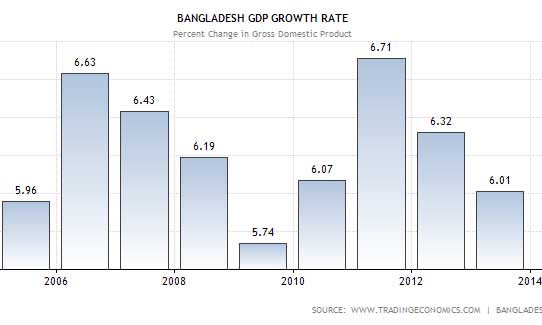The independent multidisciplinary think tank Unnayan Onneshan (UO) in its pre-budget issue of Bangladesh Economic Update identifies ten major economic challenges against the backdrop of shortfall in collection of revenue vis-à-vis target, infrastructure deficit and depressed investment, culminating into non-achievement of targeted rate of growth in gross domestic product(GDP).
The monthly update of April 2015 presents a critical analysis of the ten major economic challenges relating to growth in GDP, revenue collection, government expenditure, budget deficit, foreign aid, private sector credit, export, inflation, non-performing loan, and saving-investment gap which the economy has underwent during the FY 2014-15 and should be taken into account for the upcoming budget for FY 2015-16.
Calling for public debates for shifting the focuses of policies and functions of the ministry, the research organisation suggests three core areas – expansion of productive capacity, effective provision of social services to the citizens and sustainable development – for the next national budget of 2015-16, reports United News of Bangladesh.
In addition to shifts in policies, the UO urges restructuring the present functioning of the Ministry of Finance by dividing the functions into six divisions, i.e. Public Finance Management Division, Revenue Division, Economic Relation Division, Social Security and Development Management Division, Banking Division, and Productive Capacity Expansion Division, in order to ensure enhanced effectiveness, strengthened capabilities and greater accountability, suiting to the need of the country.
Noting that the growth in GDP has been falling short of target in recent years, the think tank projects that if the business as usual situation continues, the targeted rate of growth in GDP of 7.3 percent will not be achieved and may stand at the maximum of 6.26 percent.
Observing the shortfall in collecting revenue vis-à-vis the target, the UO finds that in FY 2014-15, the target of the collection of revenue was set at Tk 182954 crore, whereas the actual amount of revenue collection has stood at Tk 66697 crore during the first half of the current fiscal year, representing only 36.5 percent of the target.
Taking account of unsatisfactory implementation of government expenditure, the research organisation evinces that the actual amount of non-development expenditure and annual development programme expenditure has stood at Tk 59789 crore and Tk17,009 crore during the first half of FY 2014-15 against the whole fiscal year’s target of Tk 170191 crore and Tk. 80315 crore respectively, representing only 35.1 percent and 21.2 percent of respective targets.
Referring to the low budget deficit due to low implementation of budget in the current fiscal year, the think tank shows that against the target of Tk 67552 crore in FY 2014-15, the actual budget deficit has become Tk 10104 crore during the first half of the fiscal year, which has been financed by Tk 1458 crore from foreign sources and Tk 8646 crore from domestic sources (Tk 5755 crore from banking system and Tk 2891 crore from non-bank sources).
Referring to declining foreign grant and increasing foreign loan, the UO demonstrates that foreign grant and foreign loan have stood at Tk 393 crore and Tk 5275 crore respectively during July-December period of FY 2014-15 against the target of Tk 6206 crore and Tk 4502 crore set in the budget of FY 2014-15 for the whole fiscal year.
Growth in private sector credit has fallen short of the target at the end of the first half of the FY 2014-15 signaling sluggishness in business activity in the economy, comments the research organisation. The actual growth in private sector credit stood at 13.5 percent against the target of 16.5 percent set in the monetary policy statement announced by the central bank for the first half – July-December – of FY 2014-15.
Referring to increased gap between savings and investment, the research organisation evinces that in FY 2012-13 and FY 2013-14, the national savings were 30.53 percent and 30.54 percent, whereas the total investment were 28.39 percent and 28.69 percent of the GDP representing 2.14 and 1.85 percentage point gaps respectively.
The monthly update of April 2015 presents a critical analysis of the ten major economic challenges relating to growth in GDP, revenue collection, government expenditure, budget deficit, foreign aid, private sector credit, export, inflation, non-performing loan, and saving-investment gap which the economy has underwent during the FY 2014-15 and should be taken into account for the upcoming budget for FY 2015-16.
Calling for public debates for shifting the focuses of policies and functions of the ministry, the research organisation suggests three core areas – expansion of productive capacity, effective provision of social services to the citizens and sustainable development – for the next national budget of 2015-16, reports United News of Bangladesh.
In addition to shifts in policies, the UO urges restructuring the present functioning of the Ministry of Finance by dividing the functions into six divisions, i.e. Public Finance Management Division, Revenue Division, Economic Relation Division, Social Security and Development Management Division, Banking Division, and Productive Capacity Expansion Division, in order to ensure enhanced effectiveness, strengthened capabilities and greater accountability, suiting to the need of the country.
Noting that the growth in GDP has been falling short of target in recent years, the think tank projects that if the business as usual situation continues, the targeted rate of growth in GDP of 7.3 percent will not be achieved and may stand at the maximum of 6.26 percent.
Observing the shortfall in collecting revenue vis-à-vis the target, the UO finds that in FY 2014-15, the target of the collection of revenue was set at Tk 182954 crore, whereas the actual amount of revenue collection has stood at Tk 66697 crore during the first half of the current fiscal year, representing only 36.5 percent of the target.
Taking account of unsatisfactory implementation of government expenditure, the research organisation evinces that the actual amount of non-development expenditure and annual development programme expenditure has stood at Tk 59789 crore and Tk17,009 crore during the first half of FY 2014-15 against the whole fiscal year’s target of Tk 170191 crore and Tk. 80315 crore respectively, representing only 35.1 percent and 21.2 percent of respective targets.
Referring to the low budget deficit due to low implementation of budget in the current fiscal year, the think tank shows that against the target of Tk 67552 crore in FY 2014-15, the actual budget deficit has become Tk 10104 crore during the first half of the fiscal year, which has been financed by Tk 1458 crore from foreign sources and Tk 8646 crore from domestic sources (Tk 5755 crore from banking system and Tk 2891 crore from non-bank sources).
Referring to declining foreign grant and increasing foreign loan, the UO demonstrates that foreign grant and foreign loan have stood at Tk 393 crore and Tk 5275 crore respectively during July-December period of FY 2014-15 against the target of Tk 6206 crore and Tk 4502 crore set in the budget of FY 2014-15 for the whole fiscal year.
Growth in private sector credit has fallen short of the target at the end of the first half of the FY 2014-15 signaling sluggishness in business activity in the economy, comments the research organisation. The actual growth in private sector credit stood at 13.5 percent against the target of 16.5 percent set in the monetary policy statement announced by the central bank for the first half – July-December – of FY 2014-15.
Referring to increased gap between savings and investment, the research organisation evinces that in FY 2012-13 and FY 2013-14, the national savings were 30.53 percent and 30.54 percent, whereas the total investment were 28.39 percent and 28.69 percent of the GDP representing 2.14 and 1.85 percentage point gaps respectively.
Source: New Age










